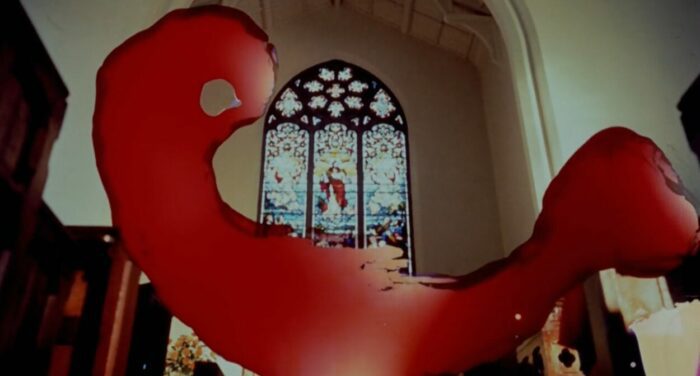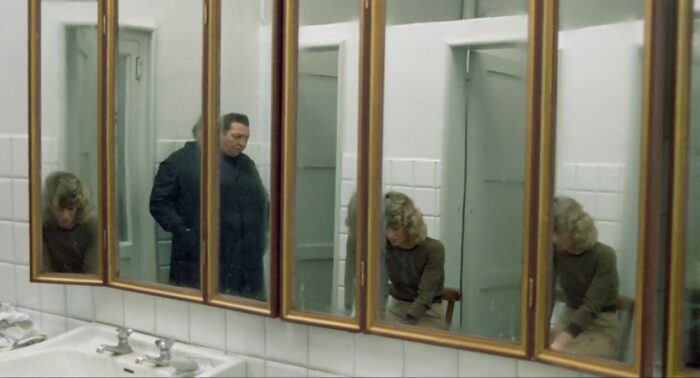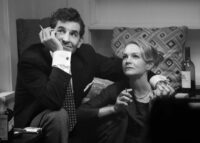Nothing is what it seems in Nicolas Roeg’s Don’t Look Now. Released 50 years ago, in 1973, this film, based on a short story by Daphne Du Maurier, focuses on a couple who are trying to cope with the loss of their daughter. But the exploration of grief takes a darker turn and what might have been a family drama becomes a mystical thriller involving psychics and messages from the dead, another world affecting ours. With a broader view though, Don’t Look Now is a story about life and reality, about looking and seeing things as they are. I deliberately don’t say “life and death,” because death is a part of life here, rather than something excluding it.
The film starts with the accidental death of a little girl, Christine, who falls into a pond and drowns. Then we follow her parents, John (Donald Sutherland) and Laura Baxter (Julie Christie), to Venice where John is working on the restoration of the church. They both are trying to hold on to something that would allow them to return to normal life.
It’s always hard to get over loss, especially that of a child. But the process differs from person to person, because everyone has their connection with it, their own experience. Grief is a lonely thing, and it can separate people. John and Laura may be both sad because their daughter is not with them anymore. But there is also guilt in John’s case and looks like he cannot forgive himself for not being able to save his daughter.
Meeting two sisters, Heather (Hilary Mason) and Wendy (Clelia Matania), one of whom is a psychic, affects them differently too. Hearing from them that Christine is still with them and is happy allows Laura to start recovering and return to life. The opposite is true for John who refuses to believe what the sisters are saying, including their warning that he is in danger if they don’t leave Venice. He prefers to forget somehow and keep on living his usual life.
The confusion of unprocessed emotions and the difficulty of making sense of life after the loss are reflected in the fragmented narrative structure of the film. The story evolves like a mosaic with the important pieces missing, just like one of those that John is restoring. Not unlike how the dissolution of the sealing material destroys the structures in the church, the reality of Baxters’ life is falling apart too. These cracks either should be mended or they allow the forces from beyond and under to creep through them. The latter is especially true for John with his gift of clairvoyance, although resisted, or maybe especially because he resists it.
All the important details are already present in the opening sequence. It contains the seeds of the story later used in the film over and over again, serving as the connections between the events and hinting at their meaning. Later, new fragments appear, until everything falls into its place in the finale.
The most important symbolic elements already present in the opening sequence are colors (especially red), glass (broken or whole), and water. Red is the color connected to the death of Christine, as she was wearing a red mac. The mysterious coincidence, when John accidentally spills the water over a slide he is looking at, causing the red pigment to dissolve and cover the whole image, triggers a vision in John who rushes outside for no obvious reason. But it’s too late, he is unable to save Christine.
The slide depicts a church window with the image of Christ in a red robe, and in the corner of it is captured a mysterious figure who looks like a child wearing a red hooded coat. The red stain coming from this figure, reminding of spilled blood, serves as a premonition for the fates of both Christine and John.

The color red is like an anchor in the film that attracts the attention of the viewer and drives the development of events. It’s the color that lures John to what will turn out a dangerous path. Red can symbolize many things, both positive and negative. The slide itself is an ambivalent image where the red robe of Christ and the red coat of the mysterious figure who turns out to be a killer, are put together in one frame. Do they represent the same principle? Or is it the opposites representing a whole?
Even God may be ambivalent, or it would be more correct to say, beyond the concepts of good and evil. ‘Churches belong to God, and yet, he doesn’t seem to care about them. Does he have other priorities?’ rhetorically asks the bishop who supervises the restoration of the church. Maybe God is not what we believe he is, or his goodness is not at all what we imagine to be. Life is ambivalent. Nothing is as it seems. And everything has an opposite. Every seemingly positive image is overturned or juxtaposed with its opposite, or reflected upside down becoming its own opposite.
Another element directly connected with Christine’s death is water. The depth of the water where ordinary human sight can’t reach connects it to the unknown and unknowable. Its connection to death and the underworld becomes even more apparent when the dead bodies—those of the victims of the killer—are recovered from it in Venice.
One should be vigilant enough to navigate and stay on the surface of its waters. The sisters are in touch with another world and the dead, but they are also able to separate it from the world of the living. Heather is blind to this world but sees the dead. Interestingly, she feels comfortable in Venice. But the other sister, Wendy, is more down to earth and stays in touch with the world of the living.
And the alleys of Venice have a dark side too. In the daytime, they are full of tourists, but at night the small empty alleys look like an otherworldly place. Again, the reverse image of how it is usually perceived. The mysterious killings add to the atmosphere of danger and death. But these dark alleys for some reason seem familiar to John. Perhaps because he is already caught in this underworld. When Christine dies, it’s John who enters the water and plunges to recover Christine’s body. It’s as if he entered the underworld with his daughter.
The water also has a reflective surface. There are many scenes with mirrors and reflections. Characters often communicate through the mirrors, rather than directly. John sees Christine as the reflection in the water and it makes him follow the red-coated figure. But it’s a reflection and a reverse image belonging to the underworld. And perhaps because he refuses to look closer, he cannot distinguish right from wrong, or above from below.
Laura is often seen behind the glass. There are several images of breaking the glass, each of them connected to death or danger. But in the scenes with Laura, glass is never broken. She is somehow separated from this underworld and maybe this is why she can recover and return to life more easily. The connection provided by Heather is enough for her to become whole again. The image of her behind the glass window, watching children play on the other side, lets me think that Laura is alright with her daughter on the other side if she knows that Christine is happy.

Yet another dark side of Venice is the ‘acidity in the air’ that destroys its buildings. The city is as ambivalent as everything else in the film. The city standing in water, besides being a romantic place and kind of a miracle of civilization, also implies the danger of being devoured by that water. This makes Venice the perfect example of mankind desperately trying to fight against the symbolic depths of water.
The restoration of the church fits in this understanding. Restored windows and mosaics are fake, even though indistinguishable from the original. ‘The options are restore the fake or let it sink into the sea,’ says John who is aware of their fakeness but goes along with it. Perhaps because he is doing the same with his life, keeping the appearance of the sensible person who can cope with his grief, support and defend his wife, while he’s the one who needs saving.
And here I can’t help thinking—is this how we preserve life? By preferring to cover the reality with the fake version of it that is easier to accept and allows us to separate ourselves from it? Because we are afraid that it may be unbearable otherwise? There is always something we do not want to see, or we are just too busy and distracted to see. And even when we choose to look, our eyes may still distort the image. Thus, often we see what we want to see or are ready to see.
This is the life and reality I was talking about in the beginning. Not life as a joyful experience, but life as it is, reality unveiled, with all its ambiguity. That famously controversial sex scene may be the only thing that gives the hope that Laura and John are finding their way toward life and each other. But even that is ambiguous. Although they seem to be able to connect again and get over the separation caused by their grief, it comes as a result of the belief that Christine is with them. Even this incentive seems to be drawn from the world of the dead. And with that in mind, the scene somehow doesn’t feel that life-affirming anymore.
The narrative arc of Don’t Look Now creates a circle. It connects the ending to the beginning and joins the fragments of the story that may seem unrelated at first sight. It can give an impression of the predetermined outcome, where every step that is intended to avoid a disaster leads towards the disaster instead. But was it predetermined and unavoidable? Perhaps the answer to this lies in looking and seeing what we can, even if it frightens us, and even if it requires us to let go of loved ones and precious memories. The danger lies in refusing to see.



